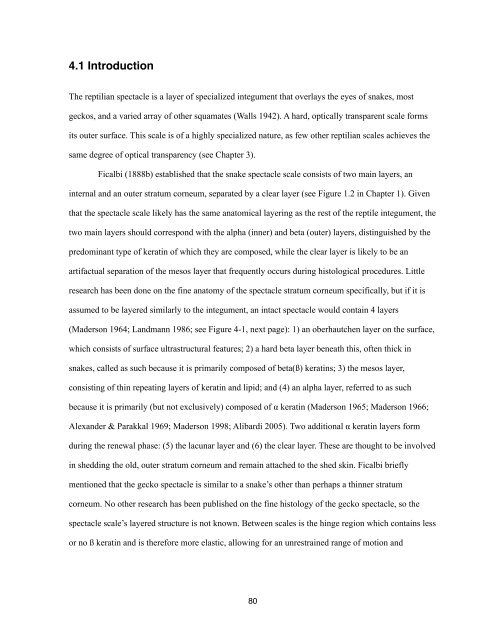Chapter 1, The Reptilian Spectacle - UWSpace - University of ...
Chapter 1, The Reptilian Spectacle - UWSpace - University of ...
Chapter 1, The Reptilian Spectacle - UWSpace - University of ...
Create successful ePaper yourself
Turn your PDF publications into a flip-book with our unique Google optimized e-Paper software.
4.1 Introduction<br />
<strong>The</strong> reptilian spectacle is a layer <strong>of</strong> specialized integument that overlays the eyes <strong>of</strong> snakes, most<br />
geckos, and a varied array <strong>of</strong> other squamates (Walls 1942). A hard, optically transparent scale forms<br />
its outer surface. This scale is <strong>of</strong> a highly specialized nature, as few other reptilian scales achieves the<br />
same degree <strong>of</strong> optical transparency (see <strong>Chapter</strong> 3).<br />
Ficalbi (1888b) established that the snake spectacle scale consists <strong>of</strong> two main layers, an<br />
internal and an outer stratum corneum, separated by a clear layer (see Figure 1.2 in <strong>Chapter</strong> 1). Given<br />
that the spectacle scale likely has the same anatomical layering as the rest <strong>of</strong> the reptile integument, the<br />
two main layers should correspond with the alpha (inner) and beta (outer) layers, distinguished by the<br />
predominant type <strong>of</strong> keratin <strong>of</strong> which they are composed, while the clear layer is likely to be an<br />
artifactual separation <strong>of</strong> the mesos layer that frequently occurs during histological procedures. Little<br />
research has been done on the fine anatomy <strong>of</strong> the spectacle stratum corneum specifically, but if it is<br />
assumed to be layered similarly to the integument, an intact spectacle would contain 4 layers<br />
(Maderson 1964; Landmann 1986; see Figure 4-1, next page): 1) an oberhautchen layer on the surface,<br />
which consists <strong>of</strong> surface ultrastructural features; 2) a hard beta layer beneath this, <strong>of</strong>ten thick in<br />
snakes, called as such because it is primarily composed <strong>of</strong> beta(ß) keratins; 3) the mesos layer,<br />
consisting <strong>of</strong> thin repeating layers <strong>of</strong> keratin and lipid; and (4) an alpha layer, referred to as such<br />
because it is primarily (but not exclusively) composed <strong>of</strong> α keratin (Maderson 1965; Maderson 1966;<br />
Alexander & Parakkal 1969; Maderson 1998; Alibardi 2005). Two additional α keratin layers form<br />
during the renewal phase: (5) the lacunar layer and (6) the clear layer. <strong>The</strong>se are thought to be involved<br />
in shedding the old, outer stratum corneum and remain attached to the shed skin. Ficalbi briefly<br />
mentioned that the gecko spectacle is similar to a snake’s other than perhaps a thinner stratum<br />
corneum. No other research has been published on the fine histology <strong>of</strong> the gecko spectacle, so the<br />
spectacle scale’s layered structure is not known. Between scales is the hinge region which contains less<br />
or no ß keratin and is therefore more elastic, allowing for an unrestrained range <strong>of</strong> motion and<br />
80
















